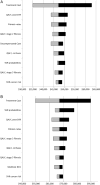The cost-effectiveness, health benefits, and financial costs of new antiviral treatments for hepatitis C virus
- PMID: 25778747
- PMCID: PMC5759765
- DOI: 10.1093/cid/civ220
The cost-effectiveness, health benefits, and financial costs of new antiviral treatments for hepatitis C virus
Abstract
Background: New hepatitis C virus (HCV) treatments deliver higher cure rates with fewer contraindications, increasing demand for treatment and healthcare costs. The cost-effectiveness of new treatments is unknown.
Methods: We conducted a microsimulation of guideline testing followed by alternative treatment regimens for HCV among the US population aged 20 and older to estimate cases identified, treated, sustained viral response, deaths, medical costs, quality-adjusted life-years (QALYs), and the incremental cost-effectiveness ratio (ICER) of different treatment options expressed as discounted lifetime costs and benefits from the healthcare perspective.
Results: Compared to treatment with pegylated interferon and ribavirin (PR), and a protease inhibitor for HCV genotype (G) 1 and PR alone for G2/3, treatment with PR and Sofosbuvir (PRS) for G1/4 and treatment with Sofosbuvir and ribavirin (SR) for G2/3 increased QALYs by 555 226, reduced deaths by 80 682, and increased costs by $26.2 billion at an ICER of $47 304 per QALY gained. As compared to PRS/SR, treating with an all oral regimen of Sofosbuvir and Simeprevir (SS) for G1/4 and SR for G2/3, increased QALYs by 1 110 451 and reduced deaths by an additional 164 540 at an incremental cost of $80.1 billion and an ICER of $72 169. In sensitivity analysis, where treatment with SS effectiveness was set to the list price of Viekira Pak and then Harvoni, treatment cost $24 921 and $25 405 per QALY gained as compared to PRS/SR.
Conclusions: New treatments are cost-effectiveness per person treated, but pent-up demand for treatment may create challenges for financing.
Keywords: antiviral treatment; cost-effectivenes; hepatitis C; pharmacoeconomics; public health.
© The Author 2015. Published by Oxford University Press on behalf of the Infectious Diseases Society of America. All rights reserved. For Permissions, please e-mail: journals.permissions@oup.com.
Conflict of interest statement
All authors have submitted the ICMJE Form for Disclosure of Potential Conflicts of Interest. Conflicts that the editors consider relevant to the content of the manuscript have been disclosed.
Figures



Comment in
-
Editorial commentary: getting smart in how we pay for HCV drugs: KAOS vs CONTROL.Clin Infect Dis. 2015 Jul 15;61(2):169-70. doi: 10.1093/cid/civ221. Epub 2015 Mar 16. Clin Infect Dis. 2015. PMID: 25778748 No abstract available.
-
Reply to Messori.Clin Infect Dis. 2015 Dec 15;61(12):1892-3. doi: 10.1093/cid/civ668. Epub 2015 Aug 10. Clin Infect Dis. 2015. PMID: 26261202 No abstract available.
-
Newest Treatments for Hepatitis C: How Can We Manage Sustainability?Clin Infect Dis. 2015 Dec 15;61(12):1891-2. doi: 10.1093/cid/civ667. Epub 2015 Aug 10. Clin Infect Dis. 2015. PMID: 26261204 No abstract available.
References
-
- CDC Division of Viral Hepatitis. Recommendations for the identification of chronic hepatitis C virus infection among persons born during 1945–1965. MMWR Recomm Rep. 2012;61(RR-4):1–32. - PubMed
-
- Moyer VA. Screening for hepatitis C virus infection in adults: US Preventive services task force recommendation statement. Ann Intern Med. 2013;159:349–57. - PubMed
-
- Zeng W, Yankey D, Ganesh N, Pineau V, Smith PJ. Using soft refusal status in the cell-phone nonresponse adjustment in the National Immunization Survey. American Statistical Association. Joint Statistical Conference. 2012
Publication types
MeSH terms
Substances
Grants and funding
LinkOut - more resources
Full Text Sources
Other Literature Sources
Research Materials
Miscellaneous

